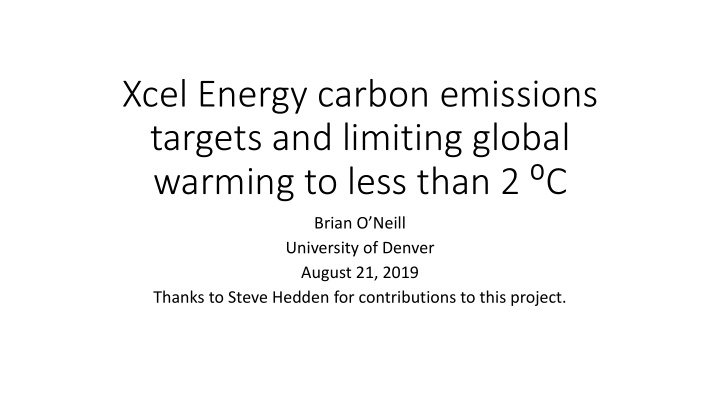



Xcel Energy carbon emissions targets and limiting global warming to less than 2 ⁰C Brian O’Neill University of Denver August 21, 2019 Thanks to Steve Hedden for contributions to this project.
Xcel Energy Electricity & natural gas company $11.4 Billion annual revenues 8 states, >5 million customers
Xcel Energy emissions reduction goals Announced December 2018 By 2030: 80% reduction in carbon emissions from electricity (relative to 2005) Achievable cost-effectively with today’s technology By 2050: 100% reduction 2030 First major utility to commit 2050 to carbon-free generation Technologies not yet commercially available at sufficient scale Xcel Energy, 2019.
How to get there Large additions of wind and solar generation Natural gas and storage technologies to balance renewables Maintain operation of nuclear plants in Upper Midwest Possible new technological developments Carbon capture and storage Storage technology Advanced nuclear Geothermal Others Xcel Energy, 2019.
Global temperature goals 2015 Paris agreement Limit global average warming Range of to “well below 2 ° C” and warming with “pursue efforts” to limit no emissions warming to 1.5°C reductions 2.0 C 1.5 C Hausfather, 2018
Are Xcel Energy emissions goals consistent with global warming targets? Emissions vs concentrations vs temperature Carbon (CO 2 ) vs all greenhouse gases Carbon emissions from electricity vs all energy vs land use Global vs single, sub-national company EPRI, 2018.
Our approach Draw on scientific literature on emissions pathways that achieve 2 C or 1.5 C targets Database of >400 model-based global emissions pathways, through 2100 Compiled to support assessment in IPCC Special Report on 1.5 C Extract most relevant results from these pathways: net carbon emissions from electricity sector in industrialized country region Exclude pathways with net negative carbon emissions at any time Compare this range of results (percentage terms) to Xcel Energy goals
Evans & Hausfather, 2018.
IAM regional disaggregation example Global Change Assessment Model (GCAM) Calvin, 2019.
Reforestation/ Net negative emissions afforestation technologies Bio-energy with carbon capture and storage (CCS) Direct air capture
Global Emissions pathways With substantial overshoot of 1.5 C achieving 1.5 C With limited or no overshoot of 1.5 C Very rapid near-term reductions Global CO2 emissions reach “net zero” around 2050 For 2 C goal, similar but reach net zero around 2070 Variety of regional outcomes underlie global results IPCC, 2018.
O’Neill & Hedden, in Xcel Energy 2018.
How robust are these results? • Emissions beyond 2050 • Emissions in other regions • Economy-wide emissions (vs electricity sector only) • How do they compare to scenarios *with* net negative emissions? • Do they rely heavily on carbon capture and storage? • Energy demand • Non-CO2 emissions • Land use • Climate policy
How robust are these results? O’Neill & Hedden, 2019.
How robust are these results? O’Neill & Hedden, 2019.
How robust are these results? O’Neill & Hedden, 2019.
How robust are these results? O’Neill & Hedden, 2019.
Summary Limiting global warming to below 2 C, and especially 1.5 C, will require substantial carbon emissions reductions -> net zero global carbon emissions by mid to late this century Xcel Energy reduction targets are consistent with electricity sector outcomes in global scenarios that achieve these goals
Recommend
More recommend